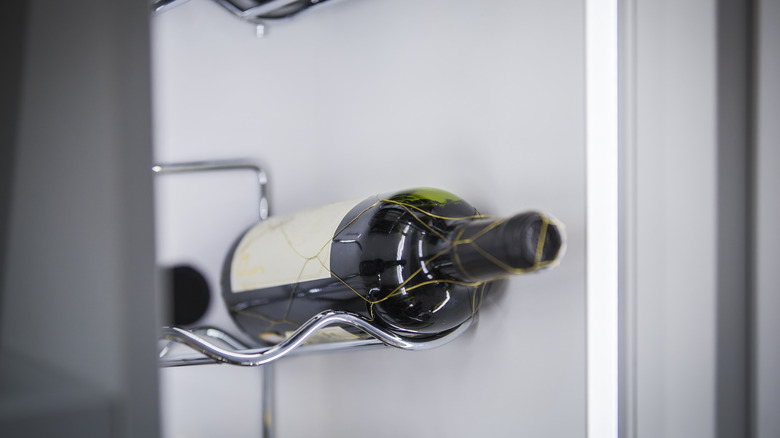The Absolute Best Way To Store Ice Wine
Ice wine is a special variety of wine that's made from grapes that are harvested in the middle of winter when the fruit is frozen over. This makes it a sweet dessert wine, perfect for enjoying after a savory meal. But, when you're not drinking it, you've got to store it somewhere.
Erin Henderson, certified sommelier and founder of the wine events company, The Wine Sisters (@the_wine_sisters on Instagram), spoke with Daily Meal in an exclusive interview to give a few insights on how to properly store your ice wine. She explains that the position you keep the wine in matters: "If you can store an unopened bottle on its side, in a wine fridge or a cool, dark basement, that's perfect. A closed bottle in the right conditions will last forever."
The way you store your wine can also have an impact on how the wine tastes when it's served. Henderson, who can be found at @itserinhenderson on Instagram and erinhenderson on Substack, provided tips on serving your ice wine, such as chilling it to the right temperature and not letting it get too warm. That way, you get the full spectrum of flavors and tasting notes when sipping on your drink.
Opened bottles have a limited shelf-life
Part of the key to storing ice wine is to store it on its side. This helps keep the cork moist, which is important because it prevents the stopper from shrinking and allowing oxygen in. If that happens, your wine can age too quickly. At the same time, that cork can impart additional flavor and complexity to the wine when you open it.
Sometimes, you're not storing away unopened bottles of ice wine. Instead, you've already had a glass or two and want to save the rest for later. If that's the case, Erin Henderson has some words of caution: "Once opened, like any wine, the clock starts ticking. Put the cork back in the bottle and put it in the fridge (for both red and white). The cold slows the evolution, and the sugar will give it a bit more longevity than table wines." The refrigerator also helps prevent bacteria from growing. Bacteria grow at faster rates in warmer temperatures. So, wine in the fridge prevents those germs from proliferating and making you sick.
Of course, you can't just stick the bottle in the fridge and leave it for an indefinite amount of time. Henderson explains, "Sealed in the fridge, you could get a month out of it without any noticeable deterioration." If you start to notice a change in color or a vinegary taste, that could be a sign that your wine has started to deteriorate.
Is there an ideal temperature for storing?
Temperature is everything when storing wine, and with ice wine, you want to keep it between 51 and 59 degrees Fahrenheit. Storing the wine in these chilly digits keeps it at the right temperature for when you're ready to serve your drink. As Erin Henderson explains, when it comes to the temperature to serve your wine at, "the rule is 10 to 12 degrees Celsius [or 50 to 54 degrees Fahrenheit]," adding, "But honestly, keep things simple for yourself, and let's just say fridge temperature." It can actually mute the aroma, too, meaning your glass won't have the same fragrant smell and will just smell, well, cold. Plus, for red ice wines, the cold can also cause your tannins to be more noticeable, leading to an overly astringent and abrasive mouthfeel.
On the other hand, if it's warmer temperatures you're dealing with, Henderson notes there are issues to be wary of too: "Anything too warm will just enhance the sugar, making it taste sickly sweet." Furthermore, wine that's served too warm may have a stronger alcohol flavor that can become overpowering. Now, if you're someone who typically decants wine, it can cause your drink to warm up more quickly than if you just served it straight into the glass. Since the sweet spot for ice wine is a cooler temperature, this may be a don't of wine decanting that you'll want to keep in mind. With these tips, you're ready to store and serve ice wine for the perfect drinking experience!


